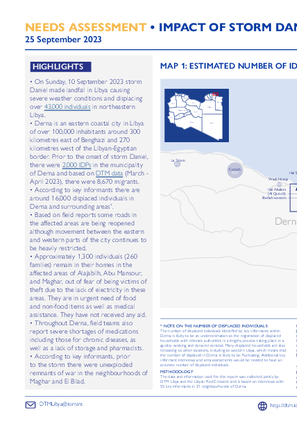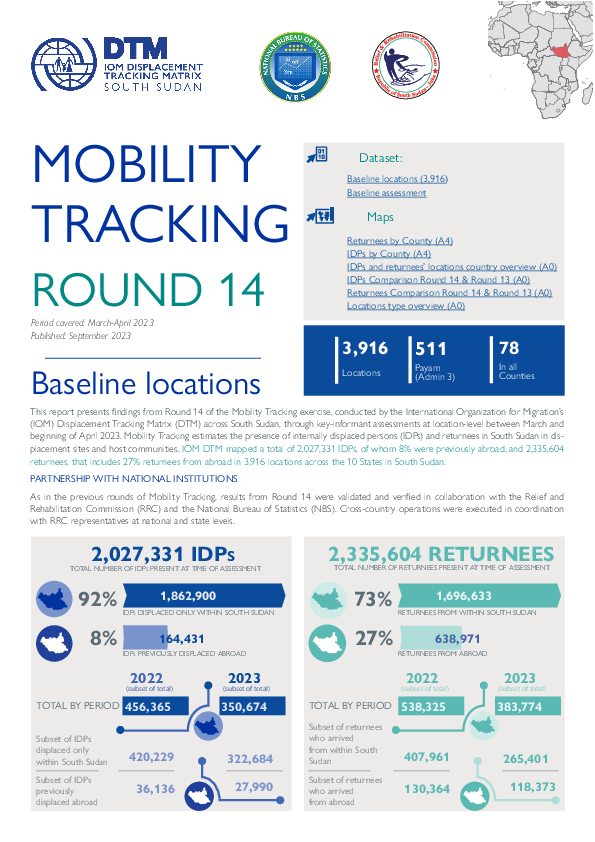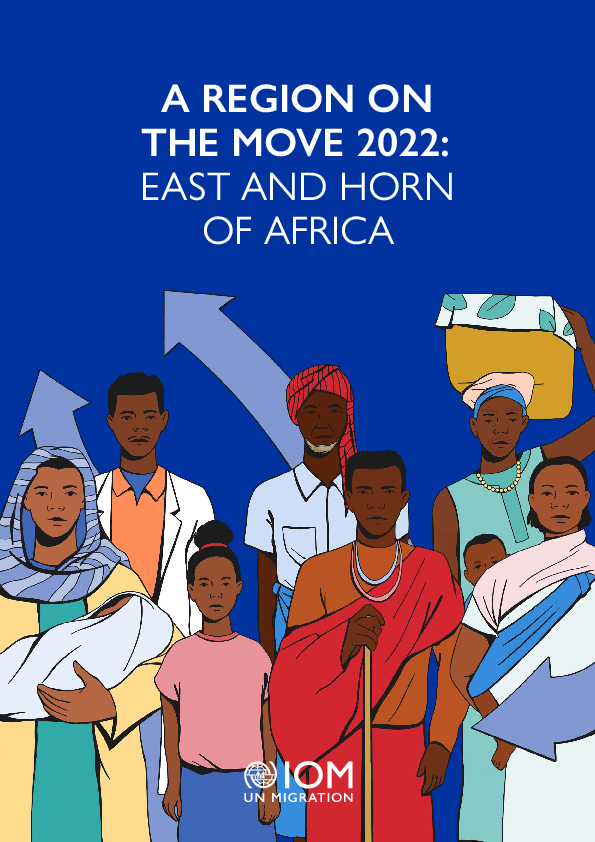-
Countries
-
Data and Analysis
-
Special Focus
-
Crisis Responses
Contact
DTM Iraq, IraqDTM@iom.int
Location
Iraq
Activity
- Mobility Tracking
- Baseline Assessment
Period Covered
May 01 2023 -Aug 31 2023
During the round 130 conducted from May to August 2023, DTM has identified 4,846,062 internal returnees (807,677 households) in 2,172 assessed return locations accross 9 Governorates and 39 districts.
Compare to the previous round, there is a increase of 10,278 returnee individuals representing (+0.2%).
Population Groups
Survey Methodology
Unit of Analysis Or Observation
Type of Survey or Assessment
Keywords
Geographical Scope
Administrative boundaries with available data
The current dataset covers the following administrative boundaries
Contact
DTM Iraq, IraqDTM@iom.int
Location
Iraq
Activity
- Mobility Tracking
- Baseline Assessment
Period Covered
May 01 2023 -Aug 31 2023
During the round 130 conducted from May to August 2023, DTM has identified 1,142,014 IDPs (195,880 households) in 2,645 assessed locations accross 18 Governorates and 104 districts.
Compare to the previous round, there is a decrease of 15,101 individuals representing (-1.31%).
Population Groups
Survey Methodology
Unit of Analysis Or Observation
Type of Survey or Assessment
Keywords
Geographical Scope
Administrative boundaries with available data
The current dataset covers the following administrative boundaries

Contact
DTMLibya@iom.int
Language
English
Location
Libya
Snapshot Date
Sep 23 2023
Activity
- Other
This report provides an overview of the situation and the main needs of the displaced population and the host community in Derna and surrounding areas.
HIGHLIGHTS
- Based on field reports some roads in the affected areas are being reopened although movement between the eastern and western parts of the city continues to be heavily restricted.
- Approximately 1,300 individuals (260 families) remain in their homes in the affected areas of Alajabilh, Abu Mansour, and Maghar, out of fear of being victims of theft due to the lack of electricity in these areas. They are in urgent need of food and non-food items as well as medical assistance. They have not received any aid.
- Throughout Derna, field teams also report severe shortages of medications including those for chronic diseases, as well as a lack of storage and pharmacists.
- Specific needs were identified for individuals with restricted mobility, women, children, infants, adults and elderly.
- Seven collective accommodations were hosting displaced individuals, mostly in schools and hotels. They lacked adequate services and items such as sanitation, security, medication, diapers, baby food, etc.
Contact
DTM Burundi, DTMBurundi@iom.int
Location
Burundi
Activity
- Mobility Tracking
- Event Tracking
Period Covered
Sep 17 2023 -Sep 23 2023
Activated on an ad hoc basis, the DTM Emergency Tracking provides early field reports at the beginning of a complex crisis, allowing IOM to gather, consolidate and disseminate baseline information on displacement and return figures at the onset of a newly emerging crisis. The DTM Emergency Tracking relies heavily on information provided by RARTs or partners within the humanitarian community about an unfolding situation. The Emergency Tracking gathers data through IOM Burundi’s extended network of key informants, who provide basic information on the new displacement, be it of IDPs or returnees, or both, including numbers, location and shelter types. While IOM DTM strives to provide best estimates, the Emergency Tracking aims to be a quick monitoring tool with real-time data turnover ranging from 24 to 72 hours following its activation.
Population Groups
Survey Methodology
Unit of Analysis Or Observation
Type of Survey or Assessment
Keywords
Geographical Scope
Administrative boundaries with available data
The current dataset covers the following administrative boundaries

Contact
SouthSudanDTM@iom.int
Language
English
Location
South Sudan
Period Covered
Mar 01 2023
Apr 30 2023
Activity
- Mobility Tracking
- Baseline Assessment
This summary presents initial findings from Round 14 of Mobility Tracking conducted across South Sudan through key-informant assessments at location-level in April 2023. Mobility Tracking estimates the presence of internally displaced persons (IDPs) and returnees in South Sudan in displacement sites and host communities. IOM DTM mapped a total of 2,027,331 IDPs, of whom 8% were previously abroad, and 2,335,604 returnees, that includes 27% returnees from abroad in 3,916 locations across the 10 States in South Sudan.
Месечен преглед на:
- Пристигнувања во Западен Балкан
- Топ три националности при пристигнување во извештајниот месец
- Присуство на мигранти во прифатните објекти
- Присуство на мигранти надвор од прифатните објекти
- Враќање и реинтеграција
Mjesečni pregled:
- Dolasci na Zapadni Balkan
- Top tri nacionalnosti pri dolasku u izvještajnom mjesecu (or if you have space: Tri najzastupljenije nacionalnosti u izvještajnom mjesecu)
- Prisustvo migranata u prihvatnim centrima
- Prisustvo migranata van prihvatnih centara
- Povratak i reintegracija
Përmbledhje mujore e:
• Mbërritjeve në Ballkanin Perëndimor
• Tre kombësive kryesore në mbërritjet në muajin raportues
• Pranisë së migrantëve në qendrat e pritjes
• Pranisë së migrantëve jashtë qendrave të pritjes
• Kthimeve dhe riintegrimi
Monthly Overview of:
- Arrivals in the Western Balkans
- Top three nationalities at arrivals in the reporting month
- Migrants presence in reception facilities
- Migrants presence outside reception facilities
- Returns and reintegration
The 'A Region on the Move' report series for the East and Horn of Africa' has been the regional flagship publication since 2017. The series provides an advanced understanding of the main migrant groups and the environment in which mobility takes place, with a focus on internal displacement and mixed migration flows along the major migration corridors of this region. A Region on the Move 2022, the tenth report in the series, explores mobility dynamics affecting the East and Horn of Africa region across its broader spectrum: from providing a regional overview of data and trends on international migrants to discussing specific groups of migrants, namely migrant workers, refugees, asylum seekers, internally displaced persons and irregular migrants along the main migratory corridors.





